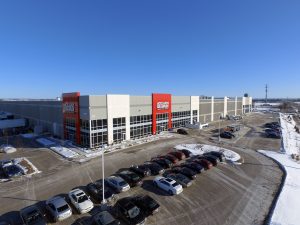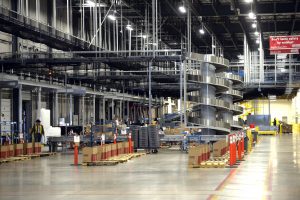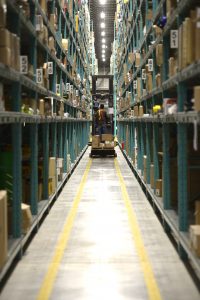

Photo Credit: Acklands-Grainger.
Distributor uses a collection of systems combined with best practices to ensure it minimizes downtime.
What do a wire guide system, a computerized maintenance management system, and a continuously moving conveyor system have in common?
These are the advanced systems being used by Acklands-Grainger at its modern distribution plant in Ontario. Intrigued about how it all comes together, MRO recently toured the plant located just north of Toronto, in Caledon, Ont. The facility, which opened in June 2015, is a sight to behold, boasting 537,227 square feet of space, approximately 150 employees, and a number of automated processes to flow products through.
One of those automated processes is a wire-guide system used by forklifts for order picking and supply restocking while going up and down aisles in the facility. Once entering the aisles, the Raymond forklifts are locked into place on the system and the operator does not need to steer the unit, which can be quite a challenge in very narrow aisles. This improves the efficiency and safety of the process by removing the possibility of human error. “From a safety perspective, you don’t have to worry about the truck hitting the racking, so the operator can run the truck more comfortably while going up and down, which results in increased productivity as they can pick and put away items a lot faster,” said Paul Distefano, National Senior Manager, DC Network Facilities, Acklands-Grainger.
The system requires very minimal maintenance. When the forklifts come in for scheduled maintenance, the wiring system is checked to make sure it is still properly bolted down, while the computer card is checked to make sure it is functioning properly.
The facility utilizes the Tririga Computerized Maintenance Management System (CMMS) from IBM, which captures all of the assets in the facility, including the spare parts needed by the maintenance staff. It allows workers to go into the system and see what schedule of work was done on a certain asset (allowing maintenance to keep track of everything on the system in real time). Work orders can be printed out from the system as needed.

Photo Credit: Acklands-Grainger.
Further, Acklands-Grainger stores spare parts in a centralized area, which is managed by CMMS. Issues that arise are quickly addressed as the inventory of parts and consumable items (such as belts and bearings) are easily accessible. Spare parts make up around 10 per cent of the whole facility system.
A facility of this size needs to ensure peak efficiency and reduce downtime. The facilities team at the facility take on that task, following the preventative maintenance schedule with daily, weekly, and monthly checks of critical assets. More specifically, maintenance on the conveyors is scheduled monthly, and they have a lifespan of 20 years if maintained properly. The forklifts, by contrast, are replaced every 10,000 hours.
Other machines that need maintenance at the facility include but are not limited to conveyance sortation system, forklifts, bailers, and pallet racking. According to the company, the biggest expense in terms of maintenance is the conveyor consumable belts (V-belts/transport belts), which need to be replaced regularly.
Other maintenance considered preventative includes facility maintenance: HVAC, dock door maintenance, fire system inspection, and service, as well as roofing and lighting. For a plant of this scope, every aspect of it needs to be maintained at peak operating efficiency to ensure minimal downtime.
MRO at the facility is done by fully licensed millwrights (industrial mechanics), heavy-equipment mechanics (for any repairs needed on forklifts), and vendors, who Acklands-Grainger makes sure to have strong partnerships with, ensuring operations stay seamless if any issues arise.
“What sets us apart from other companies is the relationship building from a contractor/vendor/manufacturer perspective with our sales team and operations. This ensures that we have a strong partnership with the vendors and, in turn, have a disproportionate amount of attention from them,” said Mindy Weir, Director, DC Operations, Acklands-Grainger. “They also have Acklands-Grainger participate at other sites and companies to do best practices sharing.”

Photo Credit: Acklands-Grainger.
Best practices at the facility are definitely on display everywhere within the building. From the time a product comes into the facility and makes its way through the process until it goes onto a trailer to be delivered, you get a sense of the many different processes that are going on in the background.
Outside of the norm, one of the most interesting machines at the facility custom builds cardboard shipping boxes for the multitude of odd-shaped objects that need to be shipped. Workers take measurements of the object and the machine creates a box that fits it nearly perfectly. This custom process ensures that there is minimal to zero waste of cardboard, thus reducing cost and ensuring less shipping material to dispose of for the customer.
Speaking of cardboard boxes, as the facility goes through a staggering number of them at the inbound process, a secondary system breaks down the boxes, compacting them and bundling them for recycling. This process is all part of Acklands-Grainger’s commitment to reducing waste and recycling.
While the facility in Caledon is the biggest, Acklands-Grainger has three other facilities in Canada. Facilities in Edmonton (328,228 square/feet), Saskatoon (112,224 sq/ft), and Winnipeg (54,000 sq/ft) serve the western Canadian market. In all, approximately 500 people work at the facilities and Acklands-Grainger stocks over 110,000 products in its network.
“Our Caledon distribution centre, one of four DCs across Canada, brings smart design, automation, and technology together to make getting product to customers fast and efficient,” said Distefano. “With that comes a continuous responsibility to keep the facility performing at peak capacity, and that’s where a rigorous maintenance facility plan comes into play. Trained, vendor-certified technicians on staff, strong vendor relationships, and a multi-layered proactive maintenance schedule help us keep our operations running so we can get our customers the products they need to keep their operations running.”

Photo Credit: Acklands-Grainger.
Acklands-Grainger Plant Processes
A quick breakdown of the inbound and outbound process at the Caledon facility shows how the company has optimized it and why it shares best practices within its facilities as well as with its industry partners.
Inbound Process
• The receiving process supports efficiency, safety, and travel within the distribution centre and cadence.
• Receiving stations are placed along the automated inbound conveyance line with support of hydraulic lifts to bring the work to a height that supports flow efficiency and team member safety.
• As shipments come in, products are received and the system generates a label that indicates where the product is to be stored.
• Products are inducted onto the conveyance line, which carries the product to the put away area based on the stocking position of the item.
• The conveyance line automatically diverts product off the conveyance at the assigned zone.
• The final step in the scanning process makes the inventory available in the system and online for customers.
Outbound Process
• Work is delivered to team members through RF units, providing employees with a specified pick path.
• Employees execute the pick task, which generates a label that follows the order through the pick process.
• Once the order is completed, it is inducted onto the outbound conveyance where it is carried to the next stage based on whether there are additional items to be consolidated to complete the order and carrier/courier selection.
• Once consolidation, packing, and preparing the shipment are complete, the RF unit sends the message to print any corresponding documents (packing slip, carrier/courier waybill).
• Labels are applied and the product is inducted back onto the outbound conveyance to the appropriate courier trailer.

